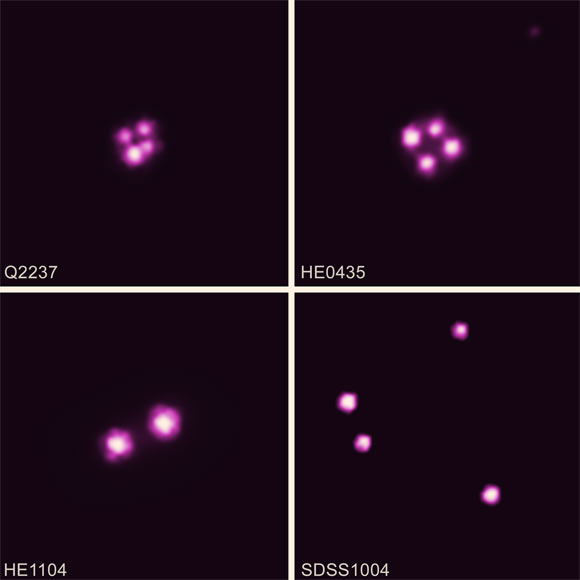By combining the capability of NASA’s Chandra X-ray Observatory with the power of a natural phenomenon called gravitational lensing, a team of astronomers studied the accretion disks of material around five supermassive black holes that are superheated and glow in X-rays. They found that the material around one of these black holes is spinning at about 70% of the speed of light.

Dai et al used Chandra to measure the spin of five quasars. Gravitational lensing of the light from each of these black holes by an intervening galaxy has created multiple images of each quasar, as shown by these Chandra images of four of the targets. Image credit: NASA / CXC / University of Oklahoma / Dai et al.
In the new study, University of Oklahoma astronomer Xinyu Dai and colleagues used Chandra and gravitational lensing to observe five distant quasars (QJ 0158-4325, HE 0435-1223, SDSS J1004+4112, HE 1104-1805 and Q 2237+0305), each consisting of a supermassive black hole rapidly consuming matter from a surrounding accretion disk.
The quasars are located at distances ranging from 8.8 billion to 10.9 billion light-years from Earth, and the black holes have masses between 160 and 500 million solar masses.
Gravitational lensing of the light from each of these quasars by an intervening galaxy has created multiple images of each quasar.
The key advance made by the researchers was that they also took advantage of ‘microlensing,’ where individual stars in the intervening, lensing galaxy provided additional magnification of the light from the quasar. A higher magnification means a smaller region is producing the X-ray emission.
The team used the property that a spinning black hole is dragging space around with it and allows matter to orbit closer to the black hole than is possible for a non-spinning black hole.
Therefore, a smaller emitting region corresponding to a tight orbit generally implies a more rapidly spinning black hole.
The scientists concluded from their microlensing analysis that the X-rays come from such a small region that the black holes must be spinning rapidly.
The results showed that one of the black holes, in the Q 2237+0305 quasar (also known as the Einstein Cross), is spinning at, or almost at, the maximum rate possible.
This corresponds to the event horizon spinning at the speed of light, which is about 670 million mph (1.08 billion kmh).
Four other black holes in the sample are spinning, on average, at about half this maximum rate.
For Q 2237+0305 the X-ray emission is from a part of the disk that is less than about 2.5 times the size of the event horizon, and for the other four quasars X-rays come from a region four to five times the event horizon size.
“How can these black holes spin so quickly? We think that these supermassive black holes likely grew by accumulating most of their material over billions of years from an accretion disk spinning with a similar orientation and direction of spin, rather than from random directions,” Dr. Dai and co-authors said.
“Like a merry-go-round that keeps getting pushed in the same direction, the black holes kept picking up speed.”
“The X-rays detected by Chandra are produced when the accretion disk surrounding the black hole creates a multimillion-degree cloud (corona) above the disk near the black hole.”
“X-rays from this corona reflect off the inner edge of the accretion disk, and the strong gravitational forces near the black hole distort the reflected X-ray spectrum, that is, the amount of X-rays seen at different energies.”
“The large distortions seen in the X-ray spectra of the quasars studied here imply that the inner edge of the disk must be close to the black holes, giving further evidence that they must be spinning rapidly.”
The team’s paper was published in the July 2, 2019 issue of the Astrophysical Journal.
_____
Xinyu Dai et al. 2019. Constraining Quasar Relativistic Reflection Regions and Spins with Microlensing. ApJ 879, 35; doi: 10.3847/1538-4357/ab1d56







